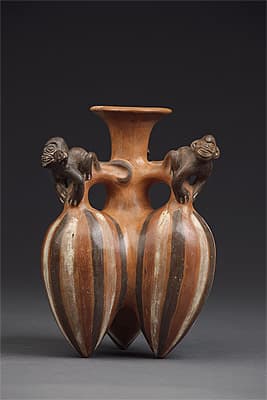
INCA culture 1400 – 1533 AD
Vessel in the form of fruit and monkeys 1400-1533 AD ceramic17.3 (h) x 12.1 (w) cm Ministerio de Cultura del Perú: Museo Nacional de Arqueología, Antropología e Historia del Perú, Photograph: Daniel Giannoni
For Inca artists, pottery lent itself both to figurative and abstract renderings of their world. The chambers of this tripartite vessel imitate water-swollen gourds (pepinos) (see cat. 99). Each handle is inhabited by an alert monkey, whose hands reach down to the fruit. Orange clay is painted with black and white stripes to represent the gourd, with black used for the monkeys. The fired jar, probably made to hold liquids, is small enough to be picked up and poured from, and therefore rests on three legs rather than the single point of an urpu (aryballos jar). Its complex form was built using the coiled-clay technique, as the potter’s wheel was unknown in pre-Columbian Peru.
Much Inca pottery is quite subdued in mood, with sombre colour harmonies. Here, the maker has observed the lively creatures’ forms and behaviour extremely acutely, and implies that the ripe fruit could be taken and eaten by thieving monkeys. The unusual motif shows the vast reach of the Inca Empire, from arid coast to jungle lowlands and highland pastures. Such vessels may have been used in everyday life, as well as for grave goods.
Christine Dixon
For Inca artists, pottery lent itself both to figurative and abstract renderings of their world. The chambers of this tripartite vessel imitate water-swollen gourds (pepinos) (see cat. 99). Each handle is inhabited by an alert monkey, whose hands reach down to the fruit. Orange clay is painted with black and white stripes to represent the gourd, with black used for the monkeys. The fired jar, probably made to hold liquids, is small enough to be picked up and poured from, and therefore rests on three legs rather than the single point of an urpu (aryballos jar). Its complex form was built using the coiled-clay technique, as the potter’s wheel was unknown in pre-Columbian Peru.
Much Inca pottery is quite subdued in mood, with sombre colour harmonies. Here, the maker has observed the lively creatures’ forms and behaviour extremely acutely, and implies that the ripe fruit could be taken and eaten by thieving monkeys. The unusual motif shows the vast reach of the Inca Empire, from arid coast to jungle lowlands and highland pastures. Such vessels may have been used in everyday life, as well as for grave goods.
Christine Dixon
For Inca artists, pottery lent itself both to figurative and abstract renderings of their world. The chambers of this tripartite vessel imitate water-swollen gourds (pepinos) (see cat. 99). Each handle is inhabited by an alert monkey, whose hands reach down to the fruit. Orange clay is painted with black and white stripes to represent the gourd, with black used for the monkeys. The fired jar, probably made to hold liquids, is small enough to be picked up and poured from, and therefore rests on three legs rather than the single point of an urpu (aryballos jar). Its complex form was built using the coiled-clay technique, as the potter’s wheel was unknown in pre-Columbian Peru.
Much Inca pottery is quite subdued in mood, with sombre colour harmonies. Here, the maker has observed the lively creatures’ forms and behaviour extremely acutely, and implies that the ripe fruit could be taken and eaten by thieving monkeys. The unusual motif shows the vast reach of the Inca Empire, from arid coast to jungle lowlands and highland pastures. Such vessels may have been used in everyday life, as well as for grave goods.
Christine Dixon

